We drove along the coast from east to west, starting at Juno beach where Canadian forces landed on June 6, 1944 as part of Operation Overlord, the largest seaborne invasion in world history. The Germans had developed massive defenses along the Normandy coast, which was the largest construction project in the 20th century, extending hundreds of miles along the entire west coast of Europe and along the coast of Norway.
Surprisingly little of it is left. There are occasional gun emplacements and bunkers. Some of the guns have been preserved, but mostly all you see are occasional pillboxes and concrete pylons. These ugly remnants of war are surrounded by charming little beach cabanas and summer vacation homes. After all, this is prime waterfront property.
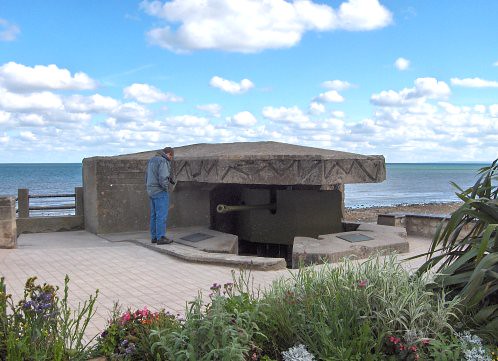
 | 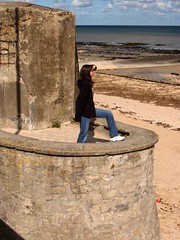 |
We proceeded from Juno beach to Sword beach. Each of the invasion beaches has a memorial of some kind, and usually a museum commemorating the sacrifices of the forces that landed there. We stopped in one cute little museum that commemorated two events: The Normandy invasion and the 1927 trans-Atlantic flight by Admiral Richard Byrd and 3 crew members to try and claim a $25,000 prize by being the first to cross the Atlantic from New York to Paris. He wound up ditching in the ocean off the Normandy coast, but if you’re interested, there’s a museum that tells the whole story.
My daughter, of course, was bored to death by the museum.
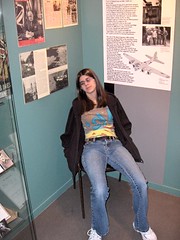
Eventually, we came to the town of Arromanches. There’s a large cliff overlooking the beach, from which you can see the incredible artificial harbor created by the Allies in a matter of days to support the landing. The port cities of Cherbourg, Le Havre, Calais, and others were too heavily defended for a successful seaborne assault, so the Allies had to build their own after taking the beaches in Normandy. They towed pre-built concrete caissons across the channel and dumped them off the coast to act as a breakwater, enabling them to move men, ammunition and machinery to support the invasion until the liberation of Antwerp in September, nearly 3 months later. It’s not intact, but is an impressive sight from the top of that cliff.
The sunken caissons sweep in a magnificent arc for thousands of feet. Down on the beach you can see some things that look like bales of hay. Those are caissons, and they're huge.
 | 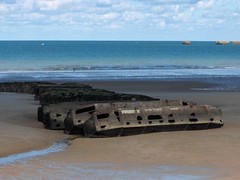 |

There’s a museum in Arromanches that looked interesting, but we we really didn’t have time to see it. However, they did have a bunch of World War II war materiel on display outside, which I found fascinating. This stuff has been lovingly, obsessively preserved, and I found myself wondering where do you go to buy tires for a World War II howitzer?
 |  |
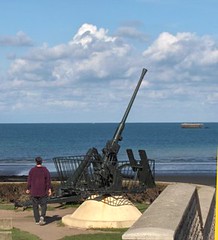 |  |
Little shops line the streets of Arromanches, where you can buy World War II uniform reproductions, as well as actual artifacts from the invasion that have been found in the area or dredged up from the ocean bottom. If you want, you can buy an actual German hand grenade (shown at top left in this display case photo), but I couldn’t figure out how to get it home on the airplane.
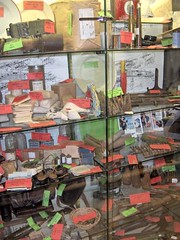 | 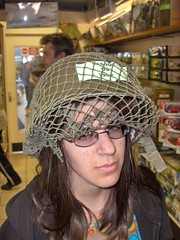 |
We continued west, eventually arriving at Omaha beach, the site of the bloodiest fighting and the greatest loss of lives in the entire invasion. Over 6,000 Americans lost their lives on this beach. It’s surprisingly pastoral, with people racing sand yachts up and down the beach.
 |  |
Hard to imagine that 60 years earlier, it looked like this:

On a clifftop overlooking the beach, we visited the American cemetery. There are war cemeteries scattered all over the region, for British, Canadian and American soldiers. There are German cemeteries as well. The American cemetery is beautifully landscaped, and very moving. Thousands of graves lie in orderly rows.

Many of the markers don’t have a name on them, bearing the legend, "Here rests in honored glory a comrade in arms known but to God." Hundreds of such markers stand in mute testimony to the chaos of war.
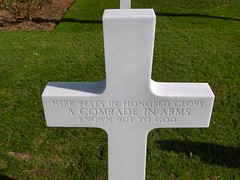 | 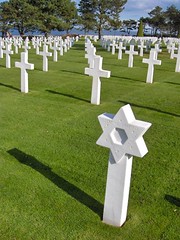 |
I spend a long time struggling to comprehend what a horrifying nightmare confronted these men 60 years ago, fighting with what we might consider primitive arms today. This neat, peaceful, manicured cemetery situated on a cliff overlooking a beautiful stretch of the Normandy coastline offers no insights into the shocking surge of death that consumed the lives of the soldiers buried here.

No comments:
Post a Comment